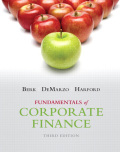
EBK FUNDAMENTALS OF CORPORATE FINANCE
3rd Edition
ISBN: 9780133762808
Author: Harford
Publisher: PEARSON CUSTOM PUB.(CONSIGNMENT)
expand_more
expand_more
format_list_bulleted
Concept explainers
Textbook Question
Chapter 11, Problem 15P
Explain the difference between the arithmetic average return you calculated in problem 16a and the geometric average return you calculated in Problem 16b. Are both numbers useful? If so, explain why
Expert Solution & Answer
Want to see the full answer?
Check out a sample textbook solution
Students have asked these similar questions
Dont use chatgpt!!
If a loan of $5,000 is taken at 8% for 1 year, what’s the interest?
No AI
Stock rises from $80 to $100. % Increase?A) 20% B) 25% C) 15% D) 10%
I need help!!
If a loan of $5,000 is taken at 8% for 1 year, what’s the interest?
Chapter 11 Solutions
EBK FUNDAMENTALS OF CORPORATE FINANCE
Ch. 11 - Prob. 1CCCh. 11 - Why do investors demand a higher return when...Ch. 11 - For what purpose do we use the average and...Ch. 11 - How does the standard deviation of historical...Ch. 11 - What is the relation between risk and return for...Ch. 11 - Prob. 6CCCh. 11 - Prob. 7CCCh. 11 - Prob. 8CCCh. 11 - Prob. 9CCCh. 11 - Does systematic or unsystematic risk require a...
Ch. 11 - What does the historical relation between...Ch. 11 - What are the components of a stock's realized...Ch. 11 - What is the intuition behind using the average...Ch. 11 - Prob. 4CTCh. 11 - How does the relationship between the average...Ch. 11 - Consider two local banks. Bank A has 100 loans...Ch. 11 - What is meant by diversification and how does it...Ch. 11 - Which of the following risks of a stock are likely...Ch. 11 - Prob. 9CTCh. 11 - Prob. 10CTCh. 11 - If you randomly select 10 stocks for a portfolio...Ch. 11 - Why doesn't the risk premium of a stock depend on...Ch. 11 - Prob. 13CTCh. 11 - DATA CASE Today is April 30, 2016, and you have...Ch. 11 - Convert these prices to monthly returns as the...Ch. 11 - Prob. 3DCCh. 11 - Prob. 4DCCh. 11 - Prob. 5DCCh. 11 - What do you notice about the average of the...Ch. 11 - Prob. 1PCh. 11 - Prob. 2PCh. 11 - Prob. 3PCh. 11 - Your portfolio consists of 100 shares of CSH and...Ch. 11 - You have just purchased a share of stock for $20....Ch. 11 - The following table contains prices and dividends...Ch. 11 - Prob. 7PCh. 11 - Prob. 8PCh. 11 - Use the data in SBUX_GOOG.xlsx on MFL to answer...Ch. 11 - Download the spreadsheet from the book's Web the...Ch. 11 - Prob. 11PCh. 11 - Prob. 12PCh. 11 - Prob. 13PCh. 11 - Consider the following five monthly returns: a....Ch. 11 - Explain the difference between the arithmetic...Ch. 11 - Prob. 16PCh. 11 - Prob. 17PCh. 11 - Prob. 18PCh. 11 - Prob. 19PCh. 11 - Prob. 20PCh. 11 - Prob. 21PCh. 11 - You are a risk-averse investor who is considering...
Knowledge Booster
Learn more about
Need a deep-dive on the concept behind this application? Look no further. Learn more about this topic, finance and related others by exploring similar questions and additional content below.Similar questions
- Stock rises from $80 to $100. % Increase?A) 20% B) 25% C) 15% D) 10%arrow_forwardFinance question 7. A person buys a stock for $100 and sells it for $120. What is the gain?A) $10B) $20C) $25D) $15arrow_forwardFinance question 7. A person buys a stock for $100 and sells it for $120. What is the gain?A) $10B) $20C) $25D) $15arrow_forward
- A person buys a stock for $100 and sells it for $120. What is the gain?A) $10B) $20C) $25D) $15arrow_forwardi need help!! If you invest $1,000 at 10% compound interest for 1 year, the amount is:A) $1,100B) $1,050C) $1,200D) $1,000arrow_forwardIf you invest $1,000 at 10% compound interest for 1 year, the amount is:A) $1,100B) $1,050C) $1,200D) $1,000arrow_forward
- I need help!! A loan of $5,000 at 6% interest for 2 years gives what simple interest?A) $600B) $500C) $300D) $200arrow_forwardA loan of $5,000 at 6% interest for 2 years gives what simple interest?A) $600B) $500C) $300D) $200arrow_forwardDear expert i need answer in this question!! What does ROI stand for in finance?A) Return on InvestmentB) Rate of InterestC) Revenue on IncomeD) Return on Insurancearrow_forward
arrow_back_ios
SEE MORE QUESTIONS
arrow_forward_ios
Recommended textbooks for you
 EBK CONTEMPORARY FINANCIAL MANAGEMENTFinanceISBN:9781337514835Author:MOYERPublisher:CENGAGE LEARNING - CONSIGNMENT
EBK CONTEMPORARY FINANCIAL MANAGEMENTFinanceISBN:9781337514835Author:MOYERPublisher:CENGAGE LEARNING - CONSIGNMENT Cornerstones of Cost Management (Cornerstones Ser...AccountingISBN:9781305970663Author:Don R. Hansen, Maryanne M. MowenPublisher:Cengage Learning
Cornerstones of Cost Management (Cornerstones Ser...AccountingISBN:9781305970663Author:Don R. Hansen, Maryanne M. MowenPublisher:Cengage Learning Managerial Accounting: The Cornerstone of Busines...AccountingISBN:9781337115773Author:Maryanne M. Mowen, Don R. Hansen, Dan L. HeitgerPublisher:Cengage Learning
Managerial Accounting: The Cornerstone of Busines...AccountingISBN:9781337115773Author:Maryanne M. Mowen, Don R. Hansen, Dan L. HeitgerPublisher:Cengage Learning Principles of Cost AccountingAccountingISBN:9781305087408Author:Edward J. Vanderbeck, Maria R. MitchellPublisher:Cengage Learning
Principles of Cost AccountingAccountingISBN:9781305087408Author:Edward J. Vanderbeck, Maria R. MitchellPublisher:Cengage Learning Essentials of Business Analytics (MindTap Course ...StatisticsISBN:9781305627734Author:Jeffrey D. Camm, James J. Cochran, Michael J. Fry, Jeffrey W. Ohlmann, David R. AndersonPublisher:Cengage Learning
Essentials of Business Analytics (MindTap Course ...StatisticsISBN:9781305627734Author:Jeffrey D. Camm, James J. Cochran, Michael J. Fry, Jeffrey W. Ohlmann, David R. AndersonPublisher:Cengage Learning

EBK CONTEMPORARY FINANCIAL MANAGEMENT
Finance
ISBN:9781337514835
Author:MOYER
Publisher:CENGAGE LEARNING - CONSIGNMENT

Cornerstones of Cost Management (Cornerstones Ser...
Accounting
ISBN:9781305970663
Author:Don R. Hansen, Maryanne M. Mowen
Publisher:Cengage Learning

Managerial Accounting: The Cornerstone of Busines...
Accounting
ISBN:9781337115773
Author:Maryanne M. Mowen, Don R. Hansen, Dan L. Heitger
Publisher:Cengage Learning

Principles of Cost Accounting
Accounting
ISBN:9781305087408
Author:Edward J. Vanderbeck, Maria R. Mitchell
Publisher:Cengage Learning

Essentials of Business Analytics (MindTap Course ...
Statistics
ISBN:9781305627734
Author:Jeffrey D. Camm, James J. Cochran, Michael J. Fry, Jeffrey W. Ohlmann, David R. Anderson
Publisher:Cengage Learning

Portfolio return, variance, standard deviation; Author: MyFinanceTeacher;https://www.youtube.com/watch?v=RWT0kx36vZE;License: Standard YouTube License, CC-BY